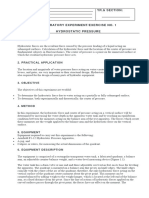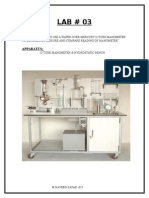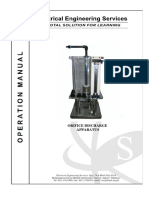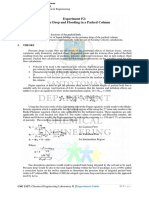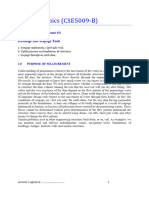Experiment 8 - Falling Sphere Viscometer Experiment
Uploaded by
Ahmed NabilExperiment 8 - Falling Sphere Viscometer Experiment
Uploaded by
Ahmed NabilME 310 Fluid Mechanics
Experiment 8 Falling Sphere Viscometer Experiment
____________________________________________________
The experiment is designed to help you understand how to determine the viscosity of a
liquid.
Objectives:
Determine the viscosity of a liquid by utilizing the terminal velocity of spheres falling
through the oils.
Calculate the drag coefficient vs. Reynolds number relationship for smooth spheres.
Reference: Sections 2-4, 3-6, and 9-7 in Intro. to Fluid Mechanics; Fox, McDonald, and
Pritchard; 6
th
edition.
Description of the apparatus:
A viscometer apparatus will be used in this experiment to find the viscosities of three
different oils. The viscometer apparatus consist of three Plexiglas tubes with 4 internal
diameter and a height of 52. The tubes are mounted in a steel bar cabinet. A white
translucent lighted backboard is mounted behind the tubes to provide good visual
conditions to observe the spheres falling in the liquid contained within the tubes. The
lighted backboard is ruled and numbered for measuring the distance the spheres fall, see
figure 8.1.
Figure 8.1: Viscometer Apparatus
8.1
Experimental Procedure:
1- To begin, obtain three sets of spheres.
2- Note that the maximum sphere size is based on a maximum sphere velocity of about
0.25 ft/sec, above this value terminal velocity may not be reached within a reasonable
distance or timing errors may be introduced. Each sphere set should be pre-tested for
each of the three liquids to make sure they meet this criterion before beginning the
experiment.
3- The spheres in each of the three sets should be the same diameter (5 for each oil); the
diameters should also be measured with a caliper. One should also weigh each of the
spheres to find the approximate mass.
4- Drop the spheres near the center of the tubes very carefully to prevent air bubbles from
forming behind the spheres and trailing in the wake.
5- Drop only one sphere at a time, this is done to facilitate ease of timing measurements.
Take five readings with each set of spheres in their respective oils for a total of 15
readings.
6- Continue by selecting at least three more spheres of various diameters which meet the
criteria of step 2 and test them in the most viscous oil to determine the drag coefficient.
Make sure to drop different diameter spheres for each reading.
7- Tabulate the data retrieved from this procedure for future determination of the
viscosity. Note that the removal of the spheres is not necessary for the completion of the
experiment. When finished, replace the wooden cap back on top of the tubes and turn off
the back light.
8.2
Assumptions and formulation:
To begin this experiment one has the task of finding the theoretical viscosity of each of
the fluids. One will assume steady incompressible flow. In the experiment, the kinematic
viscosities for each of the oils are given. To find the dynamic viscosity () one will utilize
the following relationship where is the kinematic viscosity and is the density.
l theoretica
l theoretica
= . (1)
Here one can see by simply rearranging the equation one can find the dynamic or
absolute viscosity. Once this has been complete the theoretical oil viscosity is known and
can be used as a reference for future calculations, see table 1.
theoretical
Superspin 10 Light 1.09 x 10
-5
m
2
/s 875 kg/m
3
WR Hydraulic WR 68 Medium 6.60 x 10
-5
m
2
/s 879 kg/m
3
Supro R&O 220 Heavy 2.22 x 10
-4
m
2
/s 890 kg/m
3
Table 1: Theoretical oil kinematic viscosities and densities
In this experiment, one will use Stokes equation for the calculation of the experimental
dynamic viscosity. Equation 2 will be used for this calculation.
( )
s
f s s
calculated
U
gD
18
2
= (2)
Where D
s
is the diameter of the sphere, g is the gravitational constant (9.81 m/s
2
),
s
is
the density of the sphere (kg/m
3
),
f
is the density of the viscous fluid (kg/m
3
), and U
s
is
the equivalent fall velocity of a sphere in infinite fluid (m/s). If the fluid is of finite
extent, the influence of the boundaries of the container reduces the fall velocity of the
spheres. Corrections for the finite extant of the fluid may be made to the measured
velocity U
m
, to obtain the free stream terminal velocity U
s
, in an infinite fluid by the use
of Brenners equations:
m
c
s
U
H
D
D
D
U
|
|
.
|
\
|
+ + = 95 . 1 105 . 2 1 (3)
Here D
c
is the cylinder diameter (m), H is the oil height (m), D is the sphere diameter
(m), and U
m
is the measured fall velocity (m/s). One will note however that this
calculation (equation 2) is only valid for Reynolds number less than one (Re<1);
(
=
l theoretica
f s
D U
Re . Therefore, one must calculate the Reynolds number with this
viscosity, to find if the inequality is true. If the inequality is found to be greater than one
(Re>1), a more complex quadratic equation must be used (it may be useful to separate the
terms into a, b, and c; calculate each separately; and then insert these values into the
quadratic equation when analyzing your results):
( )
0
18 16
3
2
2 2
=
(
|
.
|
\
|
+
s
f s
calculated f s calculated
U
gD
D
U
(4)
8.3
Continuing, one will calculate the drag coefficient C
d
. The drag coefficient has the same
regulations as the dynamic viscosity had in the previous equations. To formulate the drag
coefficient for Re < 1 one will consider the location where the terminal velocity takes
place. Here the drag, buoyancy force, and gravity forces on the sphere falling in a fluid
are in equilibrium. Setting the drag force equal to weight minus buoyancy force gives the
drag coefficient as:
( )
f S
f S
D
U
gD
C
2
3
4
= (5)
Again, one will note that equation 5 is only valid for Re < 1. One must consider an
additional equation for Re > 1:
2
1
Re
16
3
1
Re
24
|
.
|
\
|
+ =
D
C (6)
Finally, the % error of the dynamic viscosities can be computed using the percent of error
formula shown below:
100 * %
l theoretica
calculated l theoretica
Error
= (7)
Report requirement:
1) Determine the average of the ball velocities.
2) Using the average velocities, find the oils viscosity. Then calculate the % error of the
dynamic viscosity.
3) Once the oil viscosity is determined, compute the drag coefficient from the given
equation and the corresponding Reynolds number and make a log-log plot to obtain a
Re (x axis) vs. C
D
(y axis) relation. (Only use data from oil 3. Also fig 9.11 in the
textbook shows a Re vs C
D
plot. Note that is not a log-log plot)
Answer the following question(s) in the conclusion of the report:
How do the theoretical and calculated viscosities compare?
Is your log-log plot of Re vs. C
D
linear? Does C
D
decrease as Re increases? Explain why
or why not.
Also discuss suggestions for improvement and recommendations for further study in the
conclusion.
The report should include sample calculations; compile collected data and calculated
results in tabular form with column headings.
8.4
Experimental data and sample calculations
8.5
You might also like
- J. Chem. Thermodynamics: J. Soujanya, B. Satyavathi, T.E. Vittal PrasadNo ratings yetJ. Chem. Thermodynamics: J. Soujanya, B. Satyavathi, T.E. Vittal Prasad4 pages
- Viscosity of Fluids Lab Ball Drop MethodNo ratings yetViscosity of Fluids Lab Ball Drop Method4 pages
- 1 - Viscosity Measurement by Falling Sphere - Ver2012No ratings yet1 - Viscosity Measurement by Falling Sphere - Ver20126 pages
- Fluid and Particle Mechanics Lab ExperimentsNo ratings yetFluid and Particle Mechanics Lab Experiments4 pages
- Information Sheet For Rota Meter Test RigNo ratings yetInformation Sheet For Rota Meter Test Rig7 pages
- Fundamental of Pressure Measurement (Fluid Exp 3)No ratings yetFundamental of Pressure Measurement (Fluid Exp 3)12 pages
- Discussion & Conclusion Drag Force Prism-FaizNo ratings yetDiscussion & Conclusion Drag Force Prism-Faiz2 pages
- Apparatus For Friction Losses in Pipe Fittings ManualNo ratings yetApparatus For Friction Losses in Pipe Fittings Manual17 pages
- Composite Wall Apparatus (Bihar Communications)No ratings yetComposite Wall Apparatus (Bihar Communications)12 pages
- Wake Velocity Measurement For Flow Over A CylinderNo ratings yetWake Velocity Measurement For Flow Over A Cylinder3 pages
- Fluid Mechanics Project Search and ExperNo ratings yetFluid Mechanics Project Search and Exper26 pages
- Fluid Mechanics: Stokes' Law and Viscosity: Measurement Laboratory Investigation No. 3No ratings yetFluid Mechanics: Stokes' Law and Viscosity: Measurement Laboratory Investigation No. 37 pages
- Towards A Unified Soil Mechanics Theory: The Use of Effective Stresses in Unsaturated Soils, Revised EditionFrom EverandTowards A Unified Soil Mechanics Theory: The Use of Effective Stresses in Unsaturated Soils, Revised EditionNo ratings yet
- Fluid Mechanics I Lab Manual (MEC516 BME516 AER316) Sept 2019No ratings yetFluid Mechanics I Lab Manual (MEC516 BME516 AER316) Sept 201924 pages
- Sr. No Experiment List For Fluid Mechanics-Ii Lab Experiment NONo ratings yetSr. No Experiment List For Fluid Mechanics-Ii Lab Experiment NO19 pages
- Mechnotes: Unit Iii Reynolds ExperimentNo ratings yetMechnotes: Unit Iii Reynolds Experiment22 pages
- Accessories For Web Slings, Round Slings and High Performance SlingsNo ratings yetAccessories For Web Slings, Round Slings and High Performance Slings20 pages
- Content: - Introduction To Pipeline Hazard - Structural Hazard - Data Hazard - Control HazardNo ratings yetContent: - Introduction To Pipeline Hazard - Structural Hazard - Data Hazard - Control Hazard27 pages
- J. Chem. Thermodynamics: J. Soujanya, B. Satyavathi, T.E. Vittal PrasadJ. Chem. Thermodynamics: J. Soujanya, B. Satyavathi, T.E. Vittal Prasad
- 1 - Viscosity Measurement by Falling Sphere - Ver20121 - Viscosity Measurement by Falling Sphere - Ver2012
- Apparatus For Friction Losses in Pipe Fittings ManualApparatus For Friction Losses in Pipe Fittings Manual
- Wake Velocity Measurement For Flow Over A CylinderWake Velocity Measurement For Flow Over A Cylinder
- Fluid Mechanics: Stokes' Law and Viscosity: Measurement Laboratory Investigation No. 3Fluid Mechanics: Stokes' Law and Viscosity: Measurement Laboratory Investigation No. 3
- Towards A Unified Soil Mechanics Theory: The Use of Effective Stresses in Unsaturated Soils, Revised EditionFrom EverandTowards A Unified Soil Mechanics Theory: The Use of Effective Stresses in Unsaturated Soils, Revised Edition
- Fluid Mechanics I Lab Manual (MEC516 BME516 AER316) Sept 2019Fluid Mechanics I Lab Manual (MEC516 BME516 AER316) Sept 2019
- Sr. No Experiment List For Fluid Mechanics-Ii Lab Experiment NOSr. No Experiment List For Fluid Mechanics-Ii Lab Experiment NO
- Accessories For Web Slings, Round Slings and High Performance SlingsAccessories For Web Slings, Round Slings and High Performance Slings
- Content: - Introduction To Pipeline Hazard - Structural Hazard - Data Hazard - Control HazardContent: - Introduction To Pipeline Hazard - Structural Hazard - Data Hazard - Control Hazard














